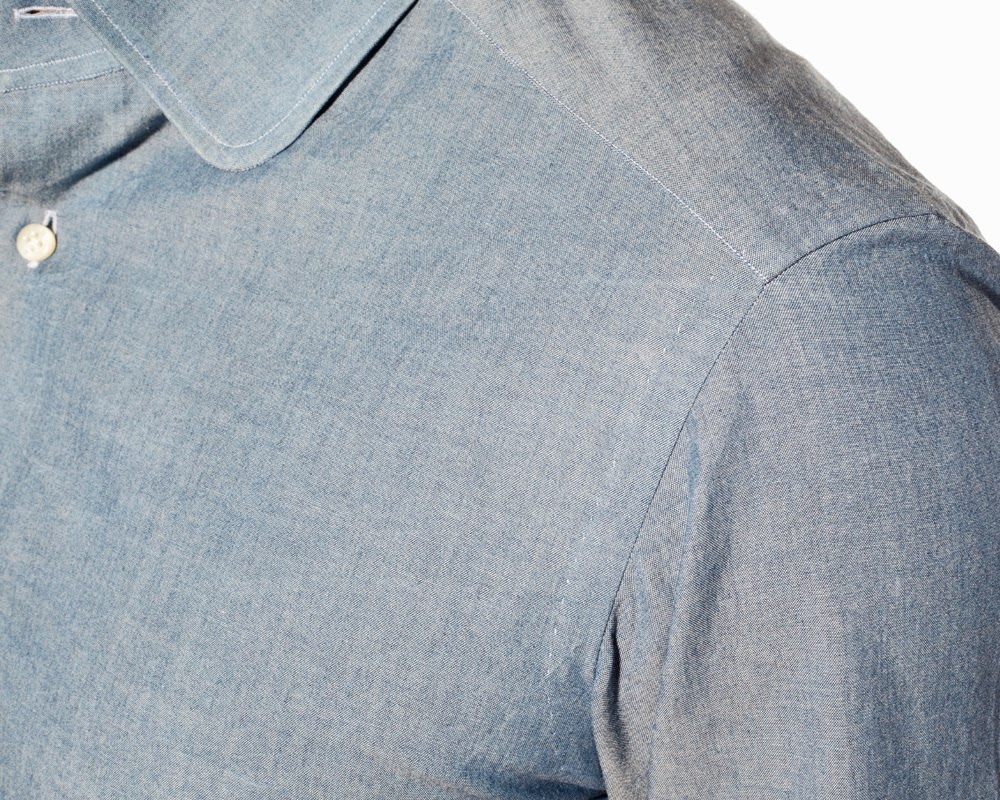How to distinguish an hand-made shirt from a machine-made one? And what does "fatto a mano" really mean? All the answers are in my fifth article for Natural Gentleman.
Come distinguere una camicia fatta a mano da una fatta a macchina? E cosa si intende davvero per "fatto a mano"? Tutte le risposte nel mio quinto articolo per Natural Gentleman.
The article - L'articolo
Born as an underwear garment, the shirt has not always been like we know it today. Allegedly, in the beginning the shirts were made like pop-overs and only in 1871 the company “Brown, Davis & Co” registered the first model with frontal buttoning. Cuffs and collar were initially removable, so that the same shirt could be worn many days in a row, just changing those parts. The misrepresentation is quite common also for the shirts, so how to distinguish an hand-made shirt from a machine-made one? And what does “fatto a mano” really mean? The distinction is not so useless, considered that, according to some, “fatto a mano” means getting the fabric with the hand and put it in the machine! Out of joke, not lots of people know these differences and the big brands are interested in keeping the consumers unaware.
First of all, it must be pointed out that an “entirely hand-made” shirt is rather unusual. A side, a sleeve or a yoke – if made by hand - can also affect the whole structure of the shirt, leading to annoying tears. Two factors are considered integral to have a good product: the fabric and the model. Skipping on the sad race of some artisans about the hand-made steps in their products, generally a good shirt should have the “Canonical Eight”. Although the name could recall dubious religious music bands, eight is the usual number of hand-made fellings that a shirt should feature. These are: armhole, button, eyelet, gusset, collar, sleeve gauntlet and cannoncino. Out of these eight, only the first two are fundamental for their functionality: the armhole for giving more flexibility in a fragile part of the shirt and the button, sewn using the crow’s foot technique, that will ensure it will never fall out. The other steps - apart from being a stylistic mannerism - only add more value to the final product, considered that more working hours are needed.
A tip: to find out whether a shirt is hand-made, look at the side seam in the point where this meets the sleeve seam. A machine-made shirt will always have these two stitchings aligned. A tailor, on the contrary, will stitch the sleeve only after the side has been closed, just like it is done for the jackets. Artisanal shirtmakers still cut by hand every single fabric, whereas big companies use machineries able to cut also two hundred fabrics at the same time. Moreover, the collar can be glued or with canvas; in the second case, fourty more minutes are needed. Ultimately, a shirt can be done by machine in about ten minutes or by hand in more than two hours and a half and the choice of the customer will fall on what is better for his needs and budget, but it is useful to make things clear in this industry, in order to know what we are buying and not to be swindled by the big brands’ marketing campaigns.
_____________________
Nata come indumento intimo, la camicia non ha sempre avuto la forma attuale. A quanto pare, infatti, veniva infilata dalla testa e per vederle assumere le sembianze odierne si dovrà attendere il 1871, anno in cui la ditta inglese Brown, Davis & Co registrò il primo modello con l’abbottonatura frontale. Polsini e colletto erano inizialmente rimovibili, permettendo così di indossarla anche per più giorni. Come in molti altri campi, anche nella camiceria la disinformazione è dilagante. Come distinguere, infatti, una camicia fatta a mano da una fatta a macchina? E cosa si intende per “fatto a mano”? Distinzione di non poco conto, se si considera che per molti “fatto a mano” significa “prendere il tessuto con la mano ed inserirlo nella macchina”! Fuor di battuta, pochi conoscono queste differenze ed i grandi brand hanno interesse a lasciare invariata questa situazione di incertezza e di dubbio tra i consumatori.
Innanzitutto, è doveroso acclarare che una camicia “interamente fatta a mano” è alquanto inusuale: avere il fianco, la cucitura interna della manica o il carrè cuciti a mano – a parte il costituire comprensibile vezzo stilitico – può essere addirittura deleterio, in quanto la struttura della camicia diventa in sé più debole e può portare a fastidiosi strappi. Per avere un buon prodotto, unanimemente riconosciuta è l’importanza di due fattori: il tessuto ed la modellistica. Inoltre, tralasciando la sterile corsa tra artigiani a chi fa più passaggi a mano nel proprio prodotto, per quanto riguarda la fase della ribattitura di solito si fa riferimento ai “Canonici Otto”. Benché il termine possa rievocare improbabili band ecclesiastiche di otto improvvisati organisti, si parla in realtà dell’usuale numero di passaggi che una camicia “interamente ribattuta a mano” dovrebbe avere. Essi riguardano giromanica, bottone, asola, mouche, collo, travetto, carrè e cannoncino. Di questi otto, i fondamentali per la loro funzionalità sono solo i primi due: il giromanica, che dà maggiore elasticità al tessuto nella parte della camicia più soggetta a frizione, ed il bottone, che se attaccato a zampa di gallina non cadrà mai. Il resto serve solo a dare maggior pregio alla camicia, per il maggior numero di ore di lavorazione necessarie a produrla.
Un consiglio: per scoprire se una camicia è fatta a macchina, si guardi la cucitura del fianco nel punto in cui incontra quella della manica. Una camicia fatta a macchina avrà sempre le due cuciture allineate. In sartoria, invece, la manica si attacca, come per la giacca, solo “a fianco chiuso”, ossia dopo aver cucito il fianco. Nelle vere camicerie artigianali, inoltre, il taglio viene effettuato ancora a mano, un tessuto alla volta, mentre nella grande distribuzione, si indulge all’utilizzo di macchinari che possono arrivare a tagliare i cosiddetti “materassi”, composti anche da cento o duecento pezze di tessuto alla volta. Non è finita qui: il collo può essere termoadesivato o intelato a mano, richiedendo nel secondo caso circa quaranta minuti in più di lavoro. In definitiva, una camicia può essere fatta a macchina in circa dieci minuti o interamente a mano in più di due ore mezza ed è ovvio che la scelta del consumatore ricadrà sul capo più adeguato ai suoi bisogni ed al suo budget, ma è bene fare chiarezza in materia per sapere cosa si sta comprando e non lasciarsi raggirare dai fumi del marketing.
If you like what we are doing here, please consider following TBD on Facebook - Tumblr - Instagram - Twitter
Bespoke Hugs,
Fabio
About hand-made shirts
4 March 2014







